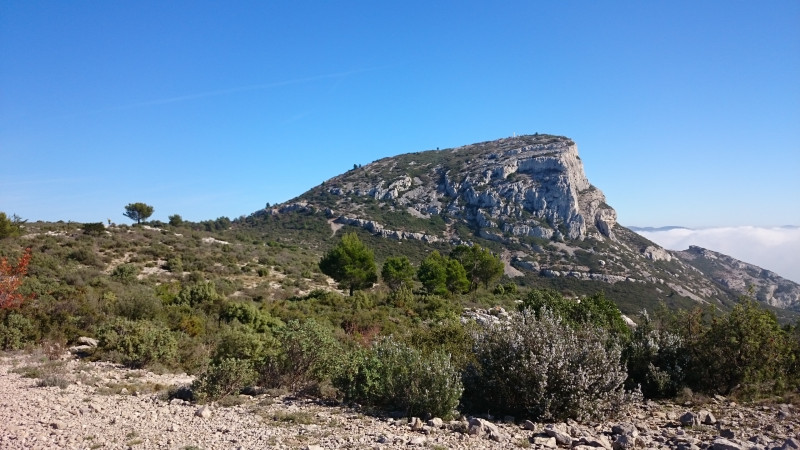Le Garlaban
MontañaPresentación
Situados en el sudeste del departamento, los macizos de Etoile y Garlaban rodean en gran medida las ciudades de Marsella y Aubagne, situadas al sur.
They are bordered to the north by the massifs of Arbois, Montaiguet, Collines de Gardanne and Regagnas, to the east by the valley of Aubagne and to the west by the A7 freeway, separating it from the massif of the Côte Bleue.
These two massifs are separated by the departmental road D908.
Due to its relief and its general east-west orientation, the ensemble formed by the Etoile and Garlaban massifs is subject to a strong masking effect with a very clear contrast between adret and ubac.
The southern slopes of Etoile and Garlaban are subject to a typical Mediterranean climate.
The northern slopes have a cooler and more humid microclimate (lower temperatures, more rainfall and shorter summer drought). The dominant wind is the Mistral, blowing from the North/Northwest.
On the southern slopes, the aerological phenomena created by the numerous valleys are complex. The wind is generally oriented North-West on the ridges, South-West to South-East up the valley bottoms, with a general acceleration on the slopes due to the slope...
The Garlaban massif presents the same contrasts with, in the North, stations of holm oak forest with the presence of pubescent oak and, in the South, scattered stands of Aleppo pine. The rate of afforestation is very low (7.5%, or 554 ha) following the numerous fires that have occurred in the massif. The most widespread formation is the scrubland (Kermes oaks, Brachypodus, Cistus, Aphyllantes of Montpellier and Gorse of Provence). The tree stratum is essentially made up of Aleppo pine (75% or more). These stands represent only 350 ha, located in the northwest of the massif and in the foothills in a discontinuous manner.
The massifs of Etoile and Garlaban constitute a natural barrier between the agglomerations of Marseille, Aix, Gardanne and Aubagne, which strongly marks the urban dynamics of the surrounding municipalities. The foothills of these massifs are thus subject to very strong land pressure due to their peri-urban position. This pressure clearly shows the absence of a transition zone between the dense urbanization and the natural environment.
As a peri-urban massif, a green lung for the agglomerations of Marseille and Aubagne and the surrounding municipalities, the Etoile and Garlaban massif plays a strong social role. The number of visitors is estimated at 250,000 per year, mainly from the local area due to the relative confidentiality of access.
The Garlaban massif is an emblematic and symbolic massif of the deep Provence, the one of Marcel Pagnol's movies. The frequentation of this massif is very marked and has led to the development of hiking trails. There are more than a hundred rare or protected species, several of which have international protection status (such as Bonelli's Eagle, the Great Horned Owl, the Short-toed Eagle).
The whole of the two massifs is in the Natura 2000 perimeter of the Etoile-Garlaban site. Finally, there is significant hunting activity on the Garlaban massif.
These two massifs are separated by the departmental road D908.
Due to its relief and its general east-west orientation, the ensemble formed by the Etoile and Garlaban massifs is subject to a strong masking effect with a very clear contrast between adret and ubac.
The southern slopes of Etoile and Garlaban are subject to a typical Mediterranean climate.
The northern slopes have a cooler and more humid microclimate (lower temperatures, more rainfall and shorter summer drought). The dominant wind is the Mistral, blowing from the North/Northwest.
On the southern slopes, the aerological phenomena created by the numerous valleys are complex. The wind is generally oriented North-West on the ridges, South-West to South-East up the valley bottoms, with a general acceleration on the slopes due to the slope...
The Garlaban massif presents the same contrasts with, in the North, stations of holm oak forest with the presence of pubescent oak and, in the South, scattered stands of Aleppo pine. The rate of afforestation is very low (7.5%, or 554 ha) following the numerous fires that have occurred in the massif. The most widespread formation is the scrubland (Kermes oaks, Brachypodus, Cistus, Aphyllantes of Montpellier and Gorse of Provence). The tree stratum is essentially made up of Aleppo pine (75% or more). These stands represent only 350 ha, located in the northwest of the massif and in the foothills in a discontinuous manner.
The massifs of Etoile and Garlaban constitute a natural barrier between the agglomerations of Marseille, Aix, Gardanne and Aubagne, which strongly marks the urban dynamics of the surrounding municipalities. The foothills of these massifs are thus subject to very strong land pressure due to their peri-urban position. This pressure clearly shows the absence of a transition zone between the dense urbanization and the natural environment.
As a peri-urban massif, a green lung for the agglomerations of Marseille and Aubagne and the surrounding municipalities, the Etoile and Garlaban massif plays a strong social role. The number of visitors is estimated at 250,000 per year, mainly from the local area due to the relative confidentiality of access.
The Garlaban massif is an emblematic and symbolic massif of the deep Provence, the one of Marcel Pagnol's movies. The frequentation of this massif is very marked and has led to the development of hiking trails. There are more than a hundred rare or protected species, several of which have international protection status (such as Bonelli's Eagle, the Great Horned Owl, the Short-toed Eagle).
The whole of the two massifs is in the Natura 2000 perimeter of the Etoile-Garlaban site. Finally, there is significant hunting activity on the Garlaban massif.
Información práctica
- Visitas :
- puedes visitarlo
- Clasificaciones :
- Natura 2000
Datos
Le Garlaban
13400
Aubagne
FICHE_INFO_SIMPLE_LIBELLE_DESTINATION
Le Garlaban
13400
Aubagne
Coordenadas GPS
Latitud : 43.3215
Longitud : 5.52603









